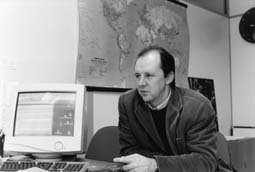Personal tools
News from ICTP 100 - Commentary

Researchers at the Elettra synchrotron facility, ICTP's 'light source' partner in Trieste, have recently discovered a holographic technique for deciphering the structure of atoms.
Atomic Holograms

Alberto Morgante
Atoms may be small, but understanding
their structure is no small matter. In fact, since the time of
the famed physicist and Nobel Prize winner Ernest Rutherford in
the early twentieth century, scientists have sought to discern
the structure or arrangement of atoms in molecules, crystals and
all sorts of biological, chemical and physical configurations.
How have they sought to accomplish this task? Relying on a variety
of tools, including spectroscopic microscopes, X-rays and synchrotron
light sources, they have literally bounced stuff off atoms in
tiny 'pinball-game-like' environments to produce a scattering
process that ultimately projects a discernible pattern. The problem
has been that the pattern could only be interpreted through time-consuming
calculations. To simplify and speed up the time for analysis,
scientists have sought to apply algorithms to generate an immediate
image of the atoms. This process is called 'inversion.'
Now a group of researchers that includes Italian physicist Alberto
Morgante, who oversees the Aloisa beamline at the Elettra
Synchrotron Light Source in Trieste, has taken the inversion process
a significant step forward by successfully marrying electron scattering
techniques to photoelectronic holography to create 'strikingly
beautiful' three-dimensional images of the local arrangement of
atoms. Morgante's work was conducted jointly with a group of researchers
at the University of Zurich in Switzerland.
There is good reason why this breakthrough technique, which has
been labelled "internal source holography," recently
received extensive press coverage in Nature, Physical
Review Letters, and Europhysics News. Previously, researchers
were forced to devise complex mathematical models to project the
possible arrangement of atoms. As Morgante explains it, "the
analytical process was a difficult one, requiring trial-and-error
procedures that were not only terribly time-consuming but often
ended in failure. After all," Morgante observes, "modelling
researchers were literally working in the dark since there was
no way to confirm the models' predictive power through experimentation
and observation."
"Internal source holography," Morgante says, "sheds
light on the structure of atoms in ways that give researchers
a reasonable fix on atomic arrangements without expending a great
deal of time or engaging in a great deal of guess work. In fact,
for simple molecules and crystals, the arrangement can be discerned
through a few straightforward mathematical calculations no more
difficult than multiplication or division."
As a result, while data collection remains a tedious task, the
analytical process has become much faster and more reliable. For
this reason, Morgante and his colleagues are anticipating that
photoelectron holography will prove an invaluable tool in a broad
range of fields, including biology (in the study of molecules),
chemistry (in the examination of catalysts), and physics (in research
on nanostructures).
Internal source holography, notes Morgante, "will reveal
the structure of small atomic clusters that cannot be crystallised
for analysis by conventional X-ray crystallography." The
result is a more precise picture of our atomic world that is likely
to reveal expanded pathways of understanding in a variety of scientific
fields.
For more detailed information about photoelectron holography,
see "Hologram of Atoms," Nature 410 (26 April
2001), pp. 1038-1039; "Imaging Atom Sites with Near Node
Photoelectron Holography," Europhysics News 32/5 (September/October
2001), pp. 172-175; and "Atomically Resolved Images from
Near Node Photoelectronic Holography Experiments on A1(111),"
Physical Review Letters 11 (12 March 2001), pp. 2337-2340.